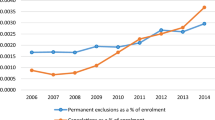Abstract
Under pressure from crowded immigration detention centres and an election commitment to remove children from detention, in 2010 the Australian government opened a low security immigration detention facility for families and children in the Adelaide Hills. Children from this alternative place of detention (APOD) attend nine local schools. However, many local residents feared their enrolment would create conflict, reduce educational outcomes for local students, and overburden teachers and school resources. To answer these concerns we conducted an ethnography of the schools and interviewed school teachers, principals, parents, the education managers in the Department of Immigration and Citizenship (DIAC) and the Department of Education and Children’s Services (DECS). This paper reports our findings on the impacts of the new arrivals on school finances, teacher time and resources, the local children, and the broader Hills community. As did previous quantitative studies, we found no negative effects. Rather, the new arrivals created a newly enriched learning environment and social experiences. The schools also played an integral role in changing the initially hostile community attitudes towards asylum seekers. Our qualitative research approach allowed us to explore factors that created this outcome. We found that the absence of negative impacts was the result of the funding for specialised support staff, the social justice orientation of the school’s leaders and staff, and a school-wide commitment to values of inclusivity and diversity. This research provides further empirical evidence on the impacts of immigration on education, increases our understanding of the factors that mediate these impacts, and provides a useful case study for schools that teach asylum seeker children.
Similar content being viewed by others
Notes
Serco was contracted by DIAC in 2009 to provide detention, transport and escort services for all Australia’s immigration detention facilities.
References
Albornoz, F., Cabrales, A., Hauk, E. (2011). Immigration and the school system. Barcelona GSE Working Paper Series no. 590. Spain: Barcelona Graduate School of Economics.
Australian Council for Educational Research (ACER) (2011). Assessment of current process for targeting of schools funding to disadvantaged students. Victoria: Australian Council for Educational Research.
Brunello, G., & Rocco, L. (2013). The effect of immigration on the school performance of natives: Cross country evidence using PISA test scores. Economics of Education Review, 32, 234–246.
Cassity, E. A., & Gow, G. (2005). Making up for lost time: Southern Sudanese young refugees in high schools. Youth Studies Australia, 24(3), 51–55.
Davies, A. Z. (2008). Characteristics of adolescent Sierra Leonean refugees in public schools in New York City. Education and Urban Society, 40(3), 361–376.
Dawson, A. (2009). Re-assessing asylum seeker dispersal in the UK: A local case study. In S. Lockie, D. Bissell, A. Greig, M. Hynes, D. Marsh, L. Saha, J. Sikora, & D. Woodman (Eds.), The future of sociology. Canberra: The Australian Sociological Association.
Esquivel, G.B., & Keitel, M.A. (1990). Counselling immigrant children in schools. Elementary School Guidance and Counselling, 24(3), 213–221.
Every, D., Rainbird, S., Procter, N., Thompson, K. & Sebben, B. (2012). Social impacts of the inverbrackie alternative place of detention on woodside and surrounds. Department of Immigration, Canberra.
Geay, C., McNally, S., & Telhaj, S. (2012). Non-native speakers of English in the classroom: What are the effects on pupil performance? Economic Journal, 123(570), 281–307.
George, A., Meadows, P., Metcalf, H., & Rolfe, H. (2011). Impact of migration on the consumption of education and children’s services and the consumption of health services, social care and social services. London: National Institute of Economic and Social Research.
Griswold, D.T. (2012). Immigration and the welfare state. The Cato Journal, 32(1). http://www.cato.org/pubs/journal/cj32n1/cj32n1.html. Accessed 10 April 2012.
Gunton, A. (2007). Refugees in our schools. Teacher, 187, 16.
Hunt, J. (2012). The impact of immigration on the educational attainment of natives. IZA Discussion Paper No. 6904: New Jersey.
Jensen, P., & Rasmussen, A. (2011). The effect of immigrant concentration in schools on native and immigrant children’s reading and math skills. Economics of Education Review, 30(6), 1503–1515.
Kirk, J., & Cassity, E. (2007). Minimum standards for quality education for refugee youth. Youth Studies Australia, 23(1), 50–56.
McEachron, G., & Bhatti, G. (2005). Language support for immigrant children: A study of state schools in the UK and US. Language, Culture and Curriculum, 18(2), 164–180.
Mickan, P., Lucas, K., Davies, B., & Lim, M. (2007). Socialisation and contestation in an ESL class of adolescent African refugees. Prospect, 22(2), 4–24.
Miller, J. (2000). Language use, identity and social interaction: Migrant students in Australia. Research on Language and Social Interaction, 33(1), 69–100.
Ohinata, A., & van Ours, J. (2013). How immigrant children affect the academic achievement of native Dutch children. The Economic Journal, 123, 308–330.
Phillips, J. & Spinks, H. (2012). Immigration Detention in Australia. Department of Parliamentary Services, Canberra.
Pugh, K., Every, D., Hattam, R. (2012 in press, accepted 6/2/2011) Supporting students with refugee experience: An ethnography of a South Australian primary school. Australian Educational Researcher.
Rousseau, C., Drapeau, A., & Corin, E. (1996). School performance and emotional problems in refugee children. American Journal of Orthopsychiatry, 66(2), 239–251.
Schneeweis, N. (2013). Immigrant concentration in schools: Consequences for native and migrant students. Working Paper Number 1302. Austria: The Austrian Centre for Labor Economics and the Analysis of the Welfare State.
Serco. (2011). Submission to the Joint Select Committee on Australia’s Immigration Detention Network.
Taylor, S. and Sidhu, R. (2012). Supporting refugee students in schools: What constitutes inclusive education? International Journal of Inclusive Education.
Vargas-Silva, C. (2011). The fiscal impact of immigration in the UK. The Migration Observatory, University of Oxford. http://www.migrationobservatory.ox.ac.uk/briefings?tid=12. Accessed 10 April 2012.
Author information
Authors and Affiliations
Corresponding author
Rights and permissions
About this article
Cite this article
Every, D., Thompson, K., Rainbird, S. et al. ‘We’re so lucky’: meeting challenges to deliver benefits to children in immigration detention. Aust. Educ. Res. 41, 209–225 (2014). https://doi.org/10.1007/s13384-013-0134-8
Received:
Accepted:
Published:
Issue Date:
DOI: https://doi.org/10.1007/s13384-013-0134-8




